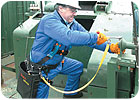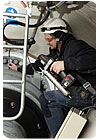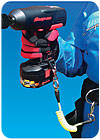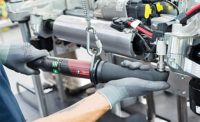
Torque is the simplest concept in the world, isn’t it? Just put the nut on the bolt and turn it until it’s tight. But what if the fastener must be tightened within a certain tolerance? What if the bolt is one metal and the nut is another? Perhaps it’s not so simple after all.
That’s why Snap-on developed a torque certification program. We put together the program in conjunction with several technical schools from around the United States, including Gateway Technical College and Lakeshore Technical College in Wisconsin; Francis Tuttle Technology Center in Oklahoma; Wichita Area Technical College in Kansas; New England Institute of Technology in Rhode Island; and South Seattle Community College and Shoreline Community College in Washington.
The colleges joined together to form NC3, The National Coalition of Certification Centers. Snap-on is partnering with this group to offer torque training as either a stand-alone option or an add-on to existing technical curricula at junior colleges or technical training centers. Snap-on provides industry certification for the group’s programs.

Snap-on’s torque certification program explores both torque theory and the correct use of tools and equipment.
Back to Basics
The perception is that applying torque to a fastener is intuitive and that anyone can do it. That’s not true when you consider how many people actually know how to do it correctly and precisely. Indeed, experienced workers are the toughest crowd to train because they’ve developed bad habits over the years. Our torque certification course forces them to relearn the basics.The program explores both torque theory and the correct use of tools and equipment. Testing for the certification emphasizes the use of real equipment as opposed to pen and paper.
The curriculum is straightforward and should be understood by all those who work in industrial settings or technology-based industries. The step-by-step program covers such topics as the importance of an anchor, how threads affect the strength of the attachment, and which materials work together and which ones don’t.
The program consists of three modules: Torque Theory, Torque Application and Safety, and Hydraulic Torque Application.
Torque Theory goes into the basics of what different fasteners do, how to identify bolts and metals, and the science and math behind fasteners and the tightening process. Torque Application and Safety covers how to use torque tools, and how to correctly calibrate and adjust them. Hydraulic Torque Application covers the technologies for tightening exceptionally large fasteners, some of which must be installed in confined spaces. The application of hydraulic torque is a skill set all by itself, requiring knowledge of hydraulic systems, correct fastener fitting, and unique safety considerations.
Of course, a good training program allows students to work with the equipment they will be using and ensures workers learn the basic “blocking and tackling” of a process, such as bolt sequencing. For example, students are taught that, when assembling a flange, the bolts must be tightened in a specific sequence to specific torque values. Students are shown the right torque sequence and how to apply the same amount of pressure on each fastener so the flange is securely attached.
The course also distinguishes between assembly and maintenance applications. On an automotive assembly line, an assembler may tighten a bolt only once. In industrial maintenance settings, however, a single bolt might have to be tightened up to five times. Our program ensures that workers understand the right technique for tightening threaded fasteners and the consequences of incorrect torque application.

Safety is the hub of the wheel when talking about torque and torque certification.
Down to the Details
Future workers need to understand torque tools and their relationships to various sizes of fasteners and extensions, as well as how working in tight places and at angles can affect torque readings.Our course covers the strength differences between fastener grades and the impact of heat treatment on fasteners. The program also explains the differences between various fasteners and shows how to determine fastener grades. For example, students are taught that when a Grade 5 nut is put onto a Grade 8 bolt, they can’t apply the same level of torque as when a Grade 8 nut is used.
Students are also shown the differences between mechanical, pneumatic, electric and hydraulic tightening tools.

Students must tighten a fastener with a wrench and ensure the tension applied falls within certain tolerances.
In the Beginning
The need for torque training was initially brought to our attention by the wind power industry. We were able to respond immediately thanks to a curriculum we had already developed for the automotive repair industry. Since then, the curriculum has expanded beyond wind power to incorporate aerospace, energy and industrial applications.Recently, a pet food manufacturer requested a customized program that all of its 30 maintenance and repair personnel could attend. The manufacturer was having a problem with fastener failures on its automated production lines. A flexible training program was tailored to meet the specific needs of this manufacturer, and it can be adapted to fit the requirements of virtually any organization or industry.
While the curriculum is the domain of the overarching NC3 organization, schools, educators, industry leaders and Snap-on representatives, certification is solely managed by Snap-on. Assessment requires a combination of hands-on application combined with an online test. Successful certification becomes part of the student’s academic record.
In addition to the extensive academic instruction, torque certification requires proof of the student’s physical abilities. For example, students must tighten a fastener with a wrench and ensure the tension applied falls within certain tolerances. It’s a pass-fail milestone in the course. This shows not only the ability to maintain the standard for the tolerance, but the hand-eye coordination that has always been part of being good with a wrench.
The program does not require any specific skills from students, beyond a basic understanding of how tools work and the role of fasteners. To date, a variety of industries have been represented in classes around the country, including workers transitioning from the automotive industry and other manufacturing sectors.
It’s easy to understand why these students are seeking the additional training. It improves safety on the job, but it also gives them an edge in competing with others for open positions. The advantage to future employers is equally clear: less on-the-job training and a workforce that walks into the plant with real-world skills.
Safety is the hub of the wheel when talking about torque and torque certification. Tightening a fastener correctly creates a better product or facility, upholds assembly standards, and instills professionalism in the ranks of maintenance technicians, installers, assemblers and construction professionals. Anyone can use a wrench, but knowing the “back story” of the tightening process is the measure of success. Holding down costs and ensuring quality is one thing, but at the end of the day it’s really safety that turns the wheel.
ASSEMBLY ONLINE
For more information on power tools, visit www.assemblymag.com to read these articles:•The Right Way and Wrong Way to Use Power Tools.
•Fastening: How Tight Is Tight?
•Torque Trade-Offs.

